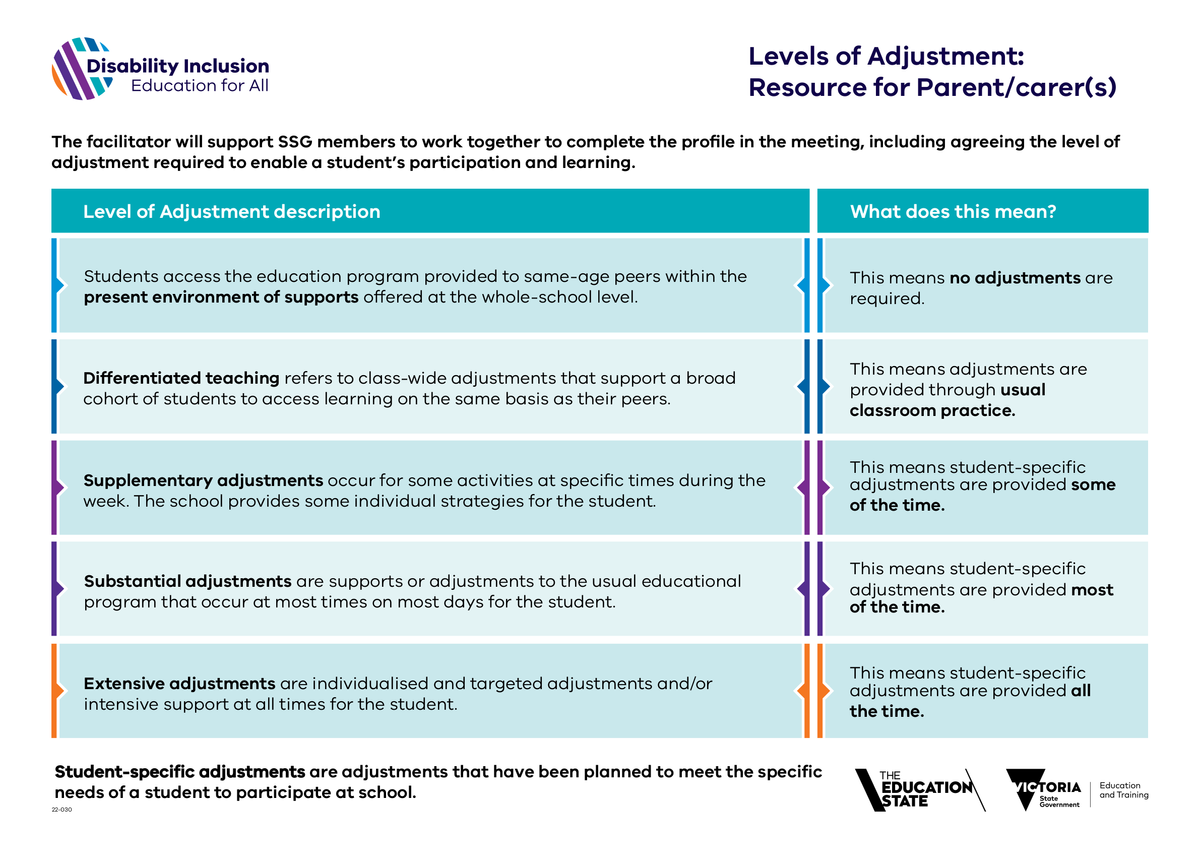Disability Inclusion & NDIS

Disability Inclusion Reform
This year, we will transition from the Program for Students with Disabilities (PSD) to Disability Inclusion (DI). All students at Jackson School must have a diagnosis of an intellectual disability in the mild range (FSIQ between 50-70). Most of our students are currently funded under the Program for Students with Disabilities under the Intellectual Disability Category. A small number of students are on an alternate placement funded under PSD in the ASD category.
The Disability Inclusion (DI) Reform is currently implemented across the South-West Region and will impact Brimbank-Melton this year.
This will replace the Program for Students with Disabilities (PSD) and the way students are currently funded to be at Jackson. This requires ongoing documentation of schools to provide substantial and extensive levels of adjustment (LoA) to help students with disability access education in all government schools. This reform is closely aligned with NDIS, including eligibility.
The 6 Domains and 31 Activities that make up the Disability Inclusion Domain Table are shown in the table below. Click on the table below to access the updated Supporting Information Guidance for Schools. This is the comprehensive version of the Domain Table we explored on our Term 2 2023 Curriculum Day.
Click here to view our new Disability Inclusion Judgement Tool
To download the Jackson School Disability Inclusion Domain Table, please click on the button below:
For more information, please visit: https://www.education.vic.gov.au/school/teachers/learningneeds/Pages/disability-inclusion.aspx
Professional Learning Videos from Assessments Australia
As part of the PSD/DI process, Teachers are required to complete a Vineland 3 to determine an Adaptive Behaviour Composite (ABC) score and Teacher Referral Form. These are independently assessed by Assessments Australia on behalf of the Department.
Colleen Goulding, the Clinical Manager of Assessments Australia, presented this professional learning session to teaching staff in 2022. To watch again, please visit:
For more information on what is an intellectual disability, please watch:
Staff can also download a range of guides from Psych4Schools to support their own professional learning. Psych4Schools provides Evidence-based practical strategies for teachers, psychologists, other professionals, and parents/carers working with children in primary and secondary schools. Psych4Schools was founded by teacher-trained psychologists. These can be accessed on the Portal through the following link:
Some of the guides include:
National Disability Insurance Scheme (NDIS)
The National Disability Insurance Scheme (NDIS) is a national approach to providing individualised support and services for people with a disability. Many of the students at our school have or will commence the process of becoming NDIS participants. NDIS is an extremely valuable program for all of our students and will allow our families to access external therapists, programs and support in the home.
Please find below the guidelines for Victorian Government schools and National Disability Insurance Scheme (NDIS) funded therapists. A family may request that an NDIS funded therapist:
- observes their child in the classroom or in the school environment (upon submission of Therapy Request Form, Parent Consent Form, Principal Approval and supporting documentation*)
- attends a Tier 3* Student Support Group (SSG) meeting to monitor and tailor the support they provide to their child (upon request to the Principal/Nominee)
NDIS is a national health initiative, so due to these practical, legal, and educational conflicts, NDIS therapy will generally not be permitted during educational time at school. In some circumstances, families may request for an NDIS funded therapist to deliver therapy at school. The decision to approve these requests rests with myself as the school Principal in consultation with the School Council. This is generally for Allied Health services that the school does not provide, for example, physiotherapy.
To ensure educational programs are not disrupted, our teaching and Allied Health staff are not directly available to support with NDIS requests. Bernadette O'Sullivan (Leading Teacher) is our NDIS Coordinator and is able to provide families with letters of support and copies of any previous assessments to support their application. No new assessments will be completed for the purpose of NDIS.
If your child is already an NDIS participant and you would like support with your planning meetings, Bernadette can provide you with a pre-prepared document with guidance about what to discuss at your planning meeting. No individual documents will be created for each individual family.
All therapy in schools or document requests related to NDIS must be directly through Bernadette O'Sullivan.
The Local Area Coordinator (LAC) is the Brotherhood of St Laurence (BSL). Their team is there to help families to access NDIS, and community and government supports. To contact BSL telephone 1300 275 634, email ndis.info@bsl.org.au, or visit https://ndis.bsl.org.au/service-areas/brimbank-melton.
If families would like more information or support with accessing NDIS, please contact our NDIS Navigator, Christine Tidswell.


